- Home
- New Kyurizukai
- Applied Physics and Physico-Informatics
from Keio's Faculty of Science and Technology
Applied Physics and Physico-Informatics
from Keio's Faculty of Science and Technology
Mathematical engineering bolstering quantum computers
Tooth and nail postdoctoral studies
Blazing a trail through new fields with positive thinking
“Where I am today is an unexpected outcome of doing what I enjoyed,” says this eternal optimist, who continues: “An abundance of encounters will lead to positive happenstance.” Perhaps what this really points to is Yamamoto-sensei’s knack for discerning the outstanding qualities of people in any given situation and for perceiving unfolding events as a stroke of good fortune. This is a lesson in never losing sight of that which is most precious; which might hold the key to achieving the freedom to enjoy giving 120% to both one’s studies and one’s pleasures without self-imposed restraints.
If one is sincere in one’s thoughts and actions and does not become a person who acts in their own self-interests the way forward will eventually reveal itself.
Find a good role model.
Naoki Yamamoto
Associate Professor, Department of Applied Physics and Physico-Informatics, Faculty of Science and Technology, Keio University. Ph.D. in Information Science and Technology. Specializes in quantum control theory and quantum information theory. Graduates Department of Mathematical Engineering and Information Physics, University of Tokyo, 1999.
In 2004 completes doctorate course at the Graduate School of Information Science and Technology, University of Tokyo. Postdoctoral Fellow in Physics and Control & Dynamical Systems, California Institute of Technology, USA from 2004 to 2006. Postdoctoral Fellow in Department of Engineering, Australian National University, Australia, from 2007 to 2008. Associate/Assistant Professor in Applied Physics and Physico-Informatics, Keio University, Japan since 2008. Dual appointment as Center Director, Quantum Computing Center in 2018.
The Research
Our latest column features Associate Professor Naoki Yamamoto who is driving research on quantum computing from theoretical perspectives.
Control theory to harness quanta: a beacon for the realization of quantum computers
Forging new fields which merge mathematical engineering with quantum mechanics
A quantum is an extremely minute substance or energy unit, and can include atoms, molecules, electrons and elementary particles. In the submicroscopic world of under one billionth of a meter, quanta dance a mysterious dance: a phenomenon which differs from any which we encounter in daily life. Efforts are now at full steam to make practical high-speed computers a reality by exploiting the characteristics of quanta. These attempts involved the challenging task of how to further quantify, understand, and subsequently control quanta. Professor Yamamoto is a quantum theorist whose research has grappled with this challenge for over twenty years.
A control theory and mathematical engineering approach
at the dawn of quantum computers
Even though the idea for quantum computers has existed for over 30 years, harnessing quanta, the very observation of which is problematic, and creating actual measurement devices was a by-no-means-easy task. According to Yamamoto, “The chance that ‘we could really make a quantum computer’ increased,” around 1998 when a “quantum teleportation experiment” by Akira Furusawa, then a researcher at the California Institute of Technology (Caltech), succeeded in conveying information instantaneously to a remote location.
Inspired by news of this success, Yamamoto began to dip his toes in the waters of quantum mechanics—in spite of the fact he had never actually specialized in this area. During this period, Yamamoto learned extensively on applied mathematics courses as a student at the Department of Mathematical Engineering and Information Physics at the University of Tokyo. He was highly influenced by Dr. Shun’ichi Amari’s “Methods of Information Geometry” in particular. He would study neural nets, an AI tool, as part of his graduation research, and control theory and information geometry during his master’s.
“Professor Amari gave me the bird’s-eye-view on mathematical engineering from the perspective of “geometry,” including statistics, control, and optimization. “Methods of Information Geometry” deals with domains such as neurons and neuroscience, and even at this early stage included a chapter on quantum information.” The spirit espoused by this volume, of attempting to achieve a handle on diverse methodologies by numerical means, was taken on board by Yamamoto in his own approach to research and still guides him today.
Yamamoto aspired to forging new fields which tied together mathematical engineering with quantum mechanics—including the control and optimization theory with which he had been engaged up until that point, and he wrote his thesis from his own new and distinctive perspective. After getting his master’s degree, he honed in on “quantum control,” undertaking a postdoc at the California Institute of Technology which was then at the top of this field and turning its hand to quantum texts on feedback theory in control engineering (controlling objects based on observations of their state.)
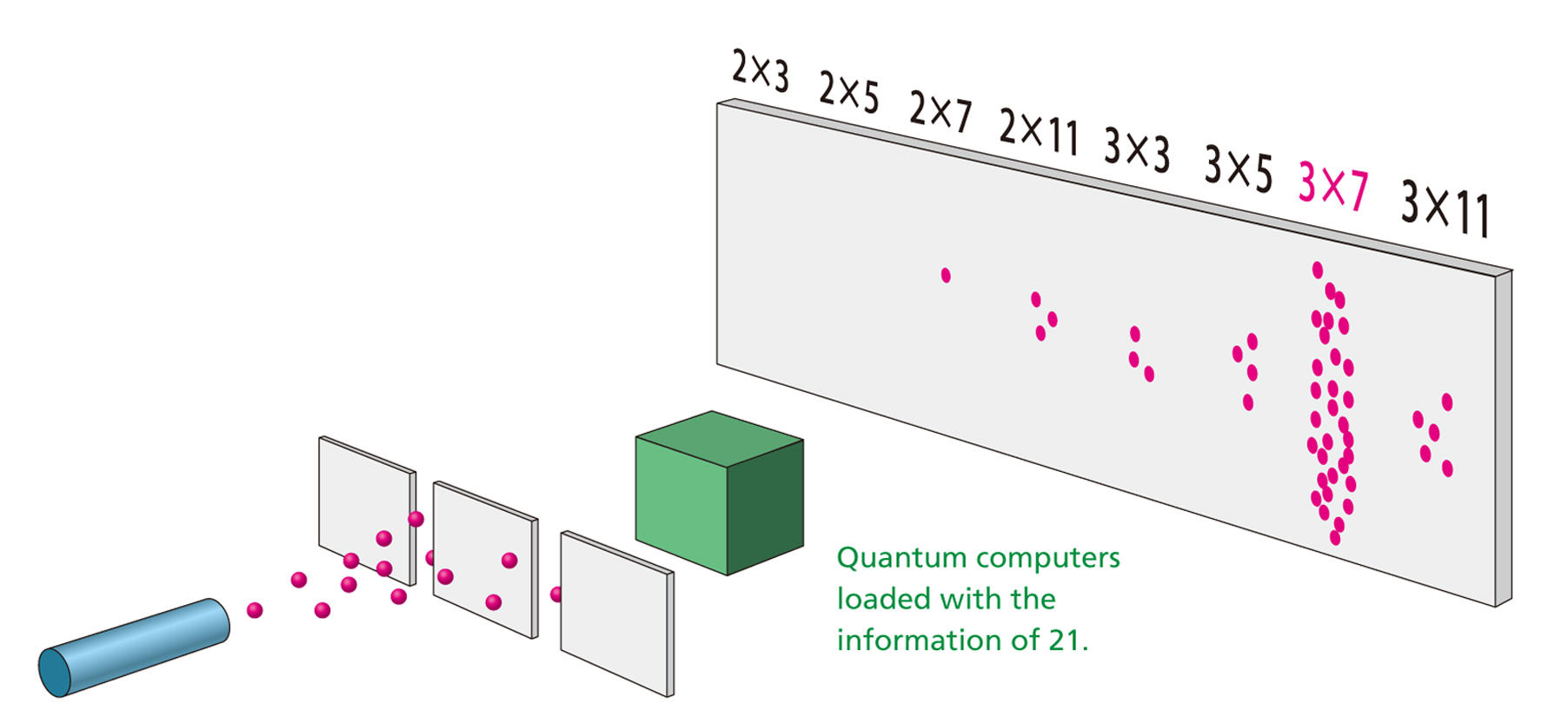
Fig.1: Quantum computer mechanism
The quantum algorithm for prime factorization unveiled by Peter Shor in 1994 is one of the major sources of perturbation in the development of quantum computers. This is because constructing a large quantum computer capable of defeating RSA encryption would represent a major security crisis. In reality, a quantum computer of thousands of qubits would be needed to do this, and it is still assumed that this possibility lies in the distant future. The below figure is a visualization of the mechanism for prime factorization of 21 using a quantum computer. Microparticles which have passed through a double slit create a stripped pattern (interference fringe) visible in the gap between screens. This happens because the microparticles which have passed through the right slit and those which have passed through the left slit overlap to reveal the characteristics of the waves. If the quantum computer loaded with the information of 21 is inserted between the slit and the screen, gaps appear in the shading of the interference fringe. These tell us “it’s around here” from amidst the various solutions which are encoded on the screen
20 years which shook the quantum world
“Control” infers that a particular state is manipulated to change this into another state. However, for this to happen one must first observe and understand the state of the object in question. For example, a robot will most likely be unable to hold a cup properly unless it can calculate both its position and dimensions. Regular computers process by distinguishing bits of 1 and 0 (1s and 0s.) However, rather than processing distinct 1s and 0s, quantum computers are concerned with states in which 1s and 0s (quantum bits/qubits) overlap. According to quantum mechanics this state is one which cannot be seen (observed.) This is because this superposition state of 1s and 0s will have dissipated into distinct 1s and 0s the instant at which it is observed.
The act of “observing” is achieved by exposing an “object” to light and measuring the reflected light. However, when these objects are of quantum size, exposing them to light changes their state. That is to say we cannot observe them by exposing them to light. This is the conventional wisdom of quantum mechanics.
“We need to control something that you must not observe (laughter.) This is the profound, inherent conundrum,” says Yamamoto. In the famous thought experiment of Schrödinger’s Cat, the cat is in a superposition state of wakefulness and sleep. But you cannot observe the cat by exposing it to normal light. This question of how one could observe the cat without being seen by the cat perplexed researchers. However, a method has already been developed to generate a unique, weak light which offers a solution to this conundrum. This gave us the means to observe Schrödinger’s Cat. Following this, a further understanding of the means of unrestricted feedback control on the cat’s state was also achieved.
The series of studies on quantum control stemming from this culminate in the Collège de France’s Serge Haroche and David J. Wineland of the National Institute of Standards and Technology receiving the Nobel Prize in Physics “for ground-breaking experimental methods that enable measuring and manipulation of individual quantum systems,” in 2012.
The systems to enable effective feedback have gradually come into existence since development of the technologies to allow observation of quantum systems began in the latter half of the 1990s. While this field had a negligible profile in mathematics when Professor Yamamoto made his way to Caltech, a number of happy coincidences made him a global forerunner in acquiring the attendant theory. His subsequent journey by way of the Australian National University brought him to where he is today.
Yamamoto’s papers were favorably received, including being verified by an experimental team at the University of California, Berkeley. He breaks a smile when recalling that: “This was an extremely happy event for a theoretician.” Yamamoto-sensei explains that “Developments of theories on how to freely control overlapping states received recognition in the form of the Novel Prize, for example, which has radically transformed the domain of quantum physics in the last twenty years.” He is now engaged with the quantization of feedback control for electronic circuits at the limits of integration by applying quantum control theory. There are expectations that this will be indispensable to the next-generation of computers and is being pursued as part of a Japan Science and Technology Agency (JST) project.
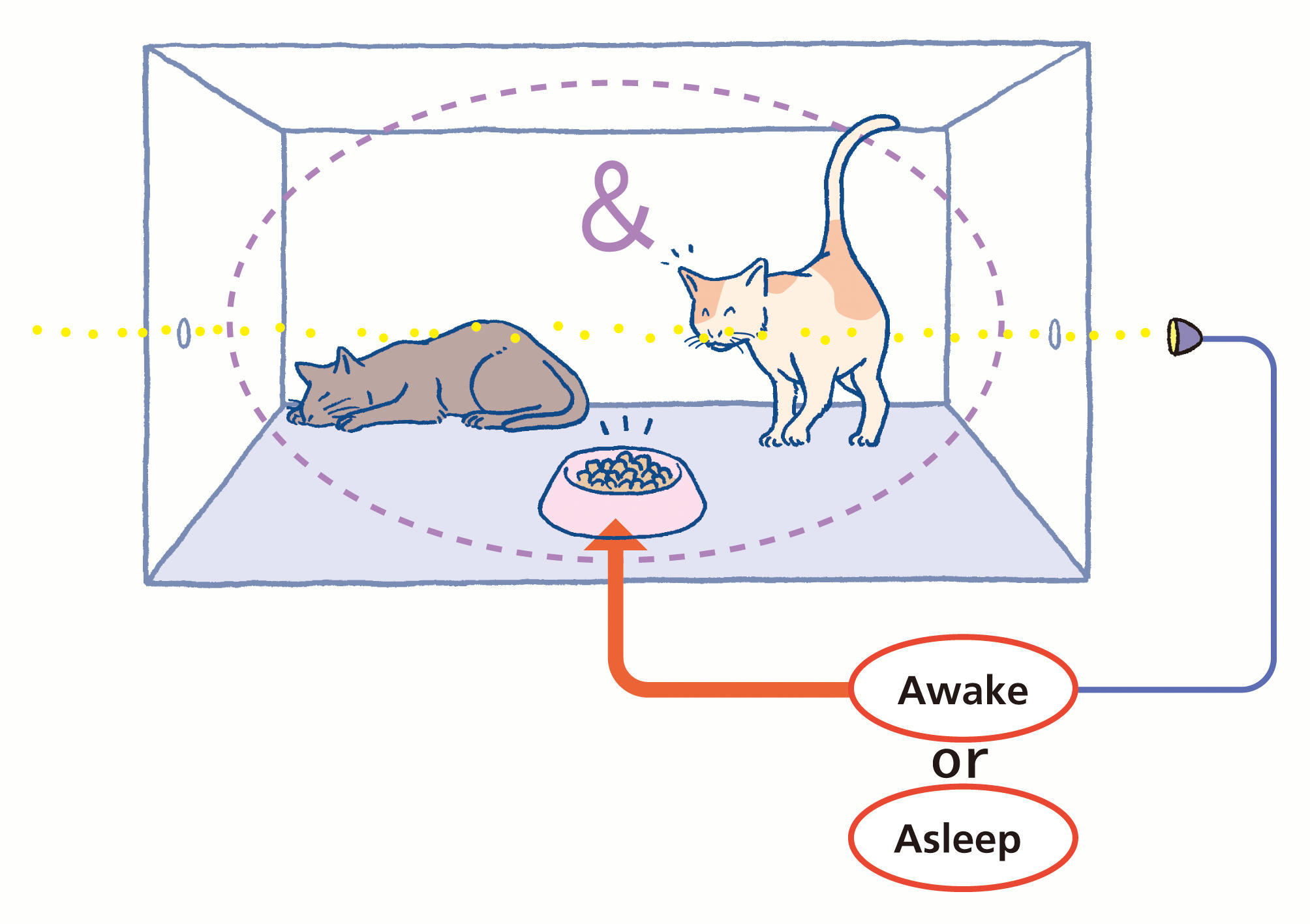
Fig.2: Taming Schrödinger’s Cat
Haroche = Haroche’s experimental schemata
1. Inside the box there is a superposition state of “light present” (the cat is awake) and “no light present” (the cat is sleeping).
2. The objective is to create “A stable state of light present.”
3. The box is exposed to ions (sufficiently weak as not to change the light status.)
4. The ions emitted from the box inform us of the light status.
5. If information indicates that there is “no light,” the light will be increased (give the cat food and wake it.)
Quantum computer research sets the world alight
With anticipation on their practical implementation growing, all eyes are now on the development of quantum computers. “Corporate giants are investing massive sums of capital in quantum computer development. There is also a huge increase in start-ups and venture companies in this area in the United States, so Japan really can’t afford to lose out,” says Yamamoto-san. In addition to the hardware development, research on the algorithms set to be used in machine learning is thriving.
At Keio University, we launched the Quantum Computing Center and established the IBM Q Network Hub*1 in May 2018, where we are now busying ourselves with quantum algorithm research using actual quantum computers of 20 quantum bits (qubits.)*2 Yamamoto-sensei, as the Director of the Quantum Computing Center, is heading up research on this program, which links up with corporate entities with a view to creating future business.
Specifically, research is being conducted on a high-speed Monte Carlo method for rapid stock market appraisals and on quantum machine learning to enhance AI by making effective use of limited data. “This links back with the fields I covered both as an undergraduate and during my master’s studies, which is certainly a stroke of good fortune. We are also aggressively engaging with various challenges of mathematical engineering. I would like to see an integration of the narratives of control and optimization, with which I was previously engaged, in the further development of mathematical engineering aspects of quantum computers,” says Yamamoto. Yamamoto’s battle continues as to how we can build on the original foundations laid by computational engineering amidst the constant evolutions in the domain of quantum computers.
*1IBM Q Network Hub
This is a mechanism launched by IBM Corporation in 2017 to construct an all-purpose quantum computing system with potential applications in business and science. Hub locations include Oak Ridge National Laboratory in the United States, University of Oxford in the United Kingdom, and Australia’s University of Melbourne, with Keio University serving as the Japan hub. A 5 qubit quantum computer can be freely accessed and used on a cloud server at the following website.
IBM Q Experience
https://quantumexperience.ng.bluemix.net/qx/experience
*2 20 qubits
As one qubit can simultaneously represent superposition states of 1s and 0s, a 20 qubit quantum computer allows superposition of 2 to the power of twenty; in other words, approximately 1 million such states. Calculation speeds are thus exponentially greater as qubits increase.
Interview
Associate Professor Naoki Yamamoto
I always wanted to be a researcher
Tell me a little about your childhood.
I was by no means raised in an environment in which science was in the air. As a child I was preoccupied with a range of pursuits with friends be it baseball, computer games, or comics. Then at junior-high school I took up tennis. I wanted to keep this up through high school, but faced with the twin powerhouses of tennis and my studies I chose to study (laughter). I renewed my relationship with tennis after entering university and remained firmly enamored through to the first year of my master’s.
When did you begin to aspire to becoming a researcher?
The desire to become a researcher in areas such as control theory and optimization theory was always bubbling away. At this point, the specifics of “what I would actually research” became imperative, and I was also interested in developments relating to quantum computers. Subsequently, I suddenly found myself researching quantum informatics during my doctorate studies. My professors also told me “You can do what you want.”
While it was risky to be engaging with a field which fell outside the specializations of the faculty members who were instructing me, I was hoping to use my expertise in mathematical engineering. My doctorate produced three major outcomes, but subsequently enjoyed some renown, for example in being cited in a paper by Peter Shaw of Massachusetts Institute of Technology, who is a big name in the quantum computer field. This was why I decided, after getting my doctorate and honing in on quantum control, to attend the California Institute of Technology (Caltech) which was then top in that field.
The path to Keio after researching overseas
How did you take to Californian life?
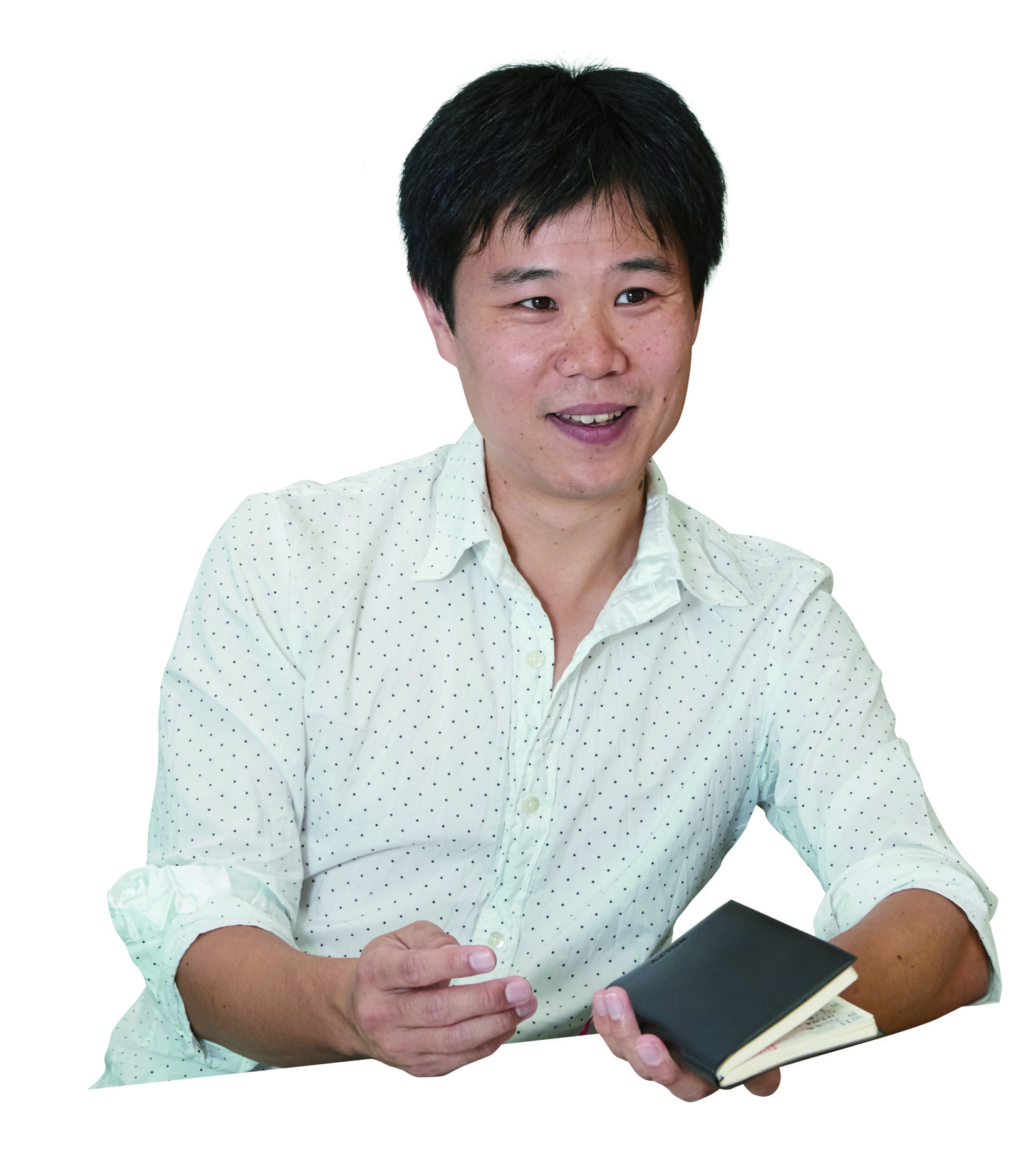
I was already married by the time I made my way to California, and I was conscious of the need to bolster my list of achievements while remaining dedicated to research. It is safe to say that I managed to get my papers out there as a result of sheer grit. As Caltech is an institute at the very pinnacle of research worldwide, both the faculty and my peers at the institution were a source of endless stimulation. What remains with me now is how blessed I was to be surrounded by good friends. Lucas Booten (Luc) was a Dutchman of my age. Important papers on quantum measurement already existed at this time, but for the most part they were rather obtuse and little-understood. However, Luc had already unraveled their secrets and he directly taught these to me. This gave me a grounding in the latest theory and allowed me to successfully publish a number of papers. The fact that these things which I did in my 20s live on in my work today, speaks to the vital importance of my experiences at Caltech. They opened the way to my securing employment both at the Australian National University and at Keio University. I am particularly grateful to Luc. During my final year in the United States I had a son, and with Luc’s blessing gave him the middle name “Lucas.”
What was your first impression of Keio University?
This year marks my 10th at Keio, surpassing my nine years at the University of Tokyo, and making Keio the place at which I have spent the longest time in my life. Most of the students are cooperative and worldly. Others ask me astute questions after classes. All the faculty and administrative staff are courteous and I am on good terms with them. I get a real sense of “Keio-ism.” My father was acquainted with Keio having graduated from the Faculty of Business and Commerce, which perhaps accounts for his initial delight on news of my appointment.
Valuable experience apart from research through the IBM Q Project
Would it be true to say that the challenges of the IBM Q Project differ from those you have encountered during your research career?
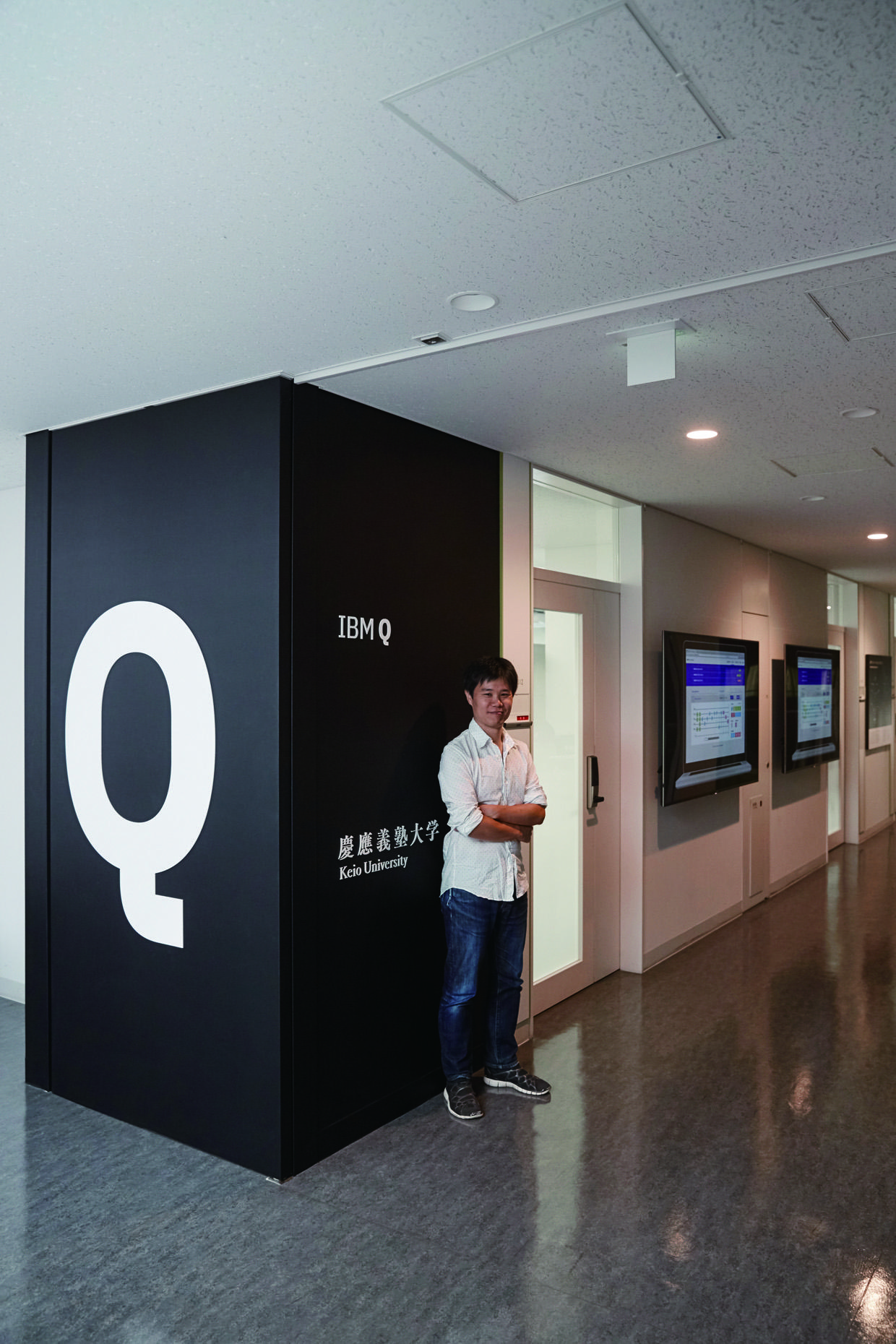
I never once imagined that I would find myself Center Director and initially took this on somewhat casually. With researchers from the project corporations stationed at the university, I encounter stimulating discussions every day across diverse fields which include finance, AI, and chemistry. What I am actually doing within the project isn’t hugely different from what I normally do. However, this is the first time my research has engaged with the perspective of attempting to “facilitate future links with business.” As you probably know, the involvement of business concerns changes the profile of any undertaking.
The center’s overarching modus operandi is innovative design is it not?
Indeed. People on the business development side in the United States and the IBM Institute in Tokyo were looking forward to the weekly dialogue with designers in London. I put forward a number of ideas but they failed to catch on (laughs). However, I am not impartial to design myself so nevertheless enjoyed this experience.
In fact, my grandfather on my mother’s side was a painter and I come from an artistic family, with my mother, grandmother, and grandfather all having attended art college. I also got awards for sketching every year from my first to my third year of junior high school. While mathematics and painting would appear to be completely unrelated, in fact mathematics at its most interesting is elegantly constructed and consequently inspiring. Perhaps there is a similar sense for wanting to create something beautiful.
Sincerity in thought and action will reveal the path forward.
Please offer a few words of encouragement to students who are currently devoting themselves to their research in the labs.
In my case, doing what made me happy was what led me to where I am today, so I cannot realistically offer any advice as to “what you should do.” However, even if you do not act purely in your own self-interest and are sincere and dedicated in your thinking and behavior wherever you may find yourself, I believe that the path forward will in time reveal itself to you.
I myself did not go about things with any particular strategy in mind. I looked around me to find that I was surrounded by extraordinary people, and put these types of people to service as my role models. While their fine research was naturally inspiring, I also found many people whose attitudes on how one should live life left a profound impression. Find a good role model in your immediate surroundings is perhaps the one piece of advice I can offer.
What kind of teacher do you yourself aspire to be?
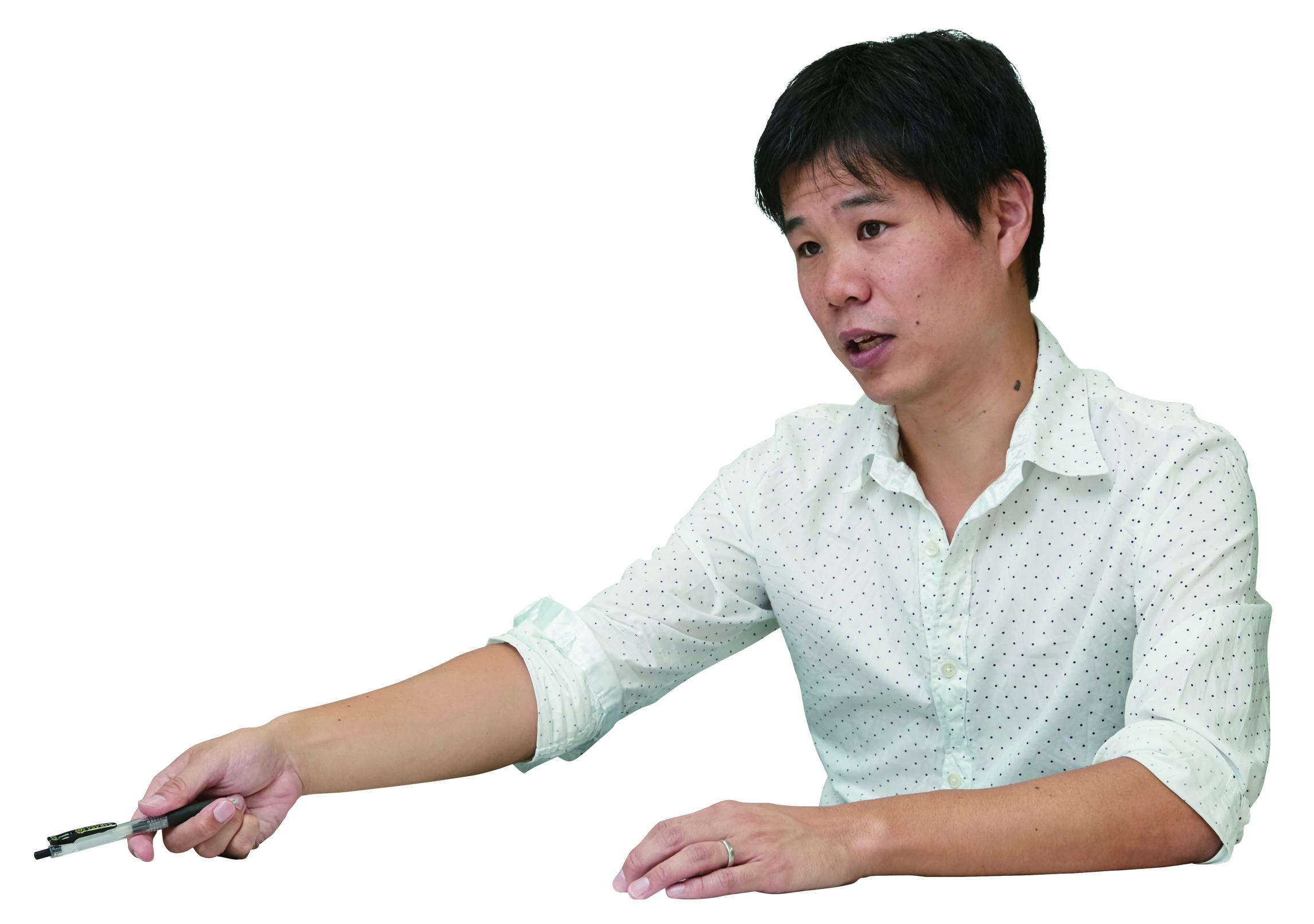
I think it is important to look like you are enjoying yourself. Rather than saying “do this and do that” to students, you should offer words of praise and encouragement. Certainly there are times when you should input with good ideas. When a student says, “I went about the calculation in this particular way which yielded the following result. What are your thoughts?!” I am particularly effusive in my praise. Keio students are almost without exception quick on the uptake, meaning that it is enough to offer minor adjustments to their course once they have begun to think and act for themselves. They will grow as long as you engage them in debate.
Some words from Students
●In many ways Yamamoto-sensei resembles a student rather than the stern image suggested by “sensei.” He is approachable and open to any ideas, and his students appreciate his emphasis on autonomy. (4th year undergraduate)
●It is great not to be bombarded with “do this, do that” pronouncements. Generally, there are various rules in the labs, and it is decided on your behalf what you will be in charge of—but with Yamamoto-sensei this is something that never happens. It is no lie to say that each and every person is free to follow their muse. You make and live by your own rules. (1st year master’s student)
(Reporter & text writer: Yuko Hiratsuka)


